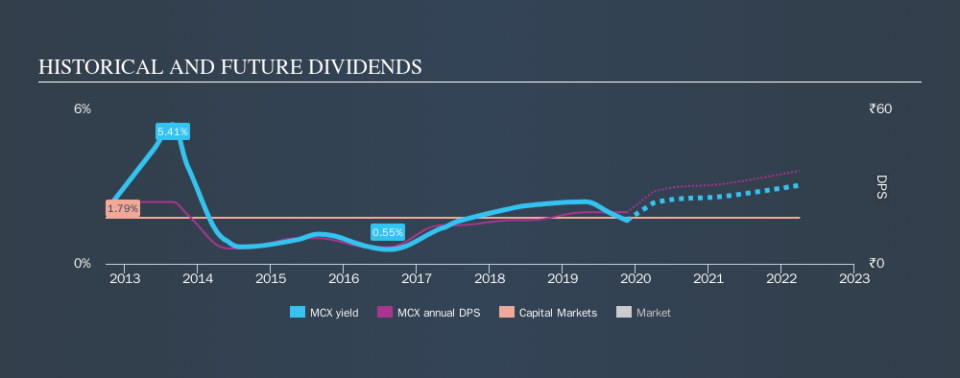Multi Commodity Exchange of India Limited (NSE:MCX) Is Yielding 1.7% - But Is It A Buy?

Dividend paying stocks like Multi Commodity Exchange of India Limited (NSE:MCX) tend to be popular with investors, and for good reason - some research suggests a significant amount of all stock market returns come from reinvested dividends. On the other hand, investors have been known to buy a stock because of its yield, and then lose money if the company's dividend doesn't live up to expectations.
With a 1.7% yield and a seven-year payment history, investors probably think Multi Commodity Exchange of India looks like a reliable dividend stock. A 1.7% yield is not inspiring, but the longer payment history has some appeal. That said, the recent jump in the share price will make Multi Commodity Exchange of India's dividend yield look smaller, even though the company prospects could be improving. Some simple analysis can offer a lot of insights when buying a company for its dividend, and we'll go through this below.
Explore this interactive chart for our latest analysis on Multi Commodity Exchange of India!
Payout ratios
Companies (usually) pay dividends out of their earnings. If a company is paying more than it earns, the dividend might have to be cut. So we need to form a view on if a company's dividend is sustainable, relative to its net profit after tax. In the last year, Multi Commodity Exchange of India paid out 47% of its profit as dividends. This is a medium payout level that leaves enough capital in the business to fund opportunities that might arise, while also rewarding shareholders. Plus, there is room to increase the payout ratio over time.
Consider getting our latest analysis on Multi Commodity Exchange of India's financial position here.
Dividend Volatility
One of the major risks of relying on dividend income, is the potential for a company to struggle financially and cut its dividend. Not only is your income cut, but the value of your investment declines as well - nasty. Multi Commodity Exchange of India has been paying a dividend for the past seven years. It's good to see that Multi Commodity Exchange of India has been paying a dividend for a number of years. However, the dividend has been cut at least once in the past, and we're concerned that what has been cut once, could be cut again. During the past seven-year period, the first annual payment was ₹24.00 in 2012, compared to ₹20.00 last year. The dividend has shrunk at around 2.6% a year during that period. Multi Commodity Exchange of India's dividend has been cut sharply at least once, so it hasn't fallen by 2.6% every year, but this is a decent approximation of the long term change.
We struggle to make a case for buying Multi Commodity Exchange of India for its dividend, given that payments have shrunk over the past seven years.
Dividend Growth Potential
With a relatively unstable dividend, it's even more important to see if earnings per share (EPS) are growing. Why take the risk of a dividend getting cut, unless there's a good chance of bigger dividends in future? Earnings have grown at around 7.3% a year for the past five years, which is better than seeing them shrink! Earnings per share have been growing at a credible rate. What's more, the payout ratio is reasonable and provides some protection to the dividend, or even the potential to increase it.
Conclusion
To summarise, shareholders should always check that Multi Commodity Exchange of India's dividends are affordable, that its dividend payments are relatively stable, and that it has decent prospects for growing its earnings and dividend. Firstly, we like that Multi Commodity Exchange of India has a low and conservative payout ratio. Unfortunately, earnings growth has also been mediocre, and the company has cut its dividend at least once in the past. In summary, we're unenthused by Multi Commodity Exchange of India as a dividend stock. It's not that we think it is a bad company; it simply falls short of our criteria in some key areas.
Earnings growth generally bodes well for the future value of company dividend payments. See if the 4 Multi Commodity Exchange of India analysts we track are forecasting continued growth with our free report on analyst estimates for the company.
We have also put together a list of global stocks with a market capitalisation above $1bn and yielding more 3%.
We aim to bring you long-term focused research analysis driven by fundamental data. Note that our analysis may not factor in the latest price-sensitive company announcements or qualitative material.
If you spot an error that warrants correction, please contact the editor at editorial-team@simplywallst.com. This article by Simply Wall St is general in nature. It does not constitute a recommendation to buy or sell any stock, and does not take account of your objectives, or your financial situation. Simply Wall St has no position in the stocks mentioned. Thank you for reading.


